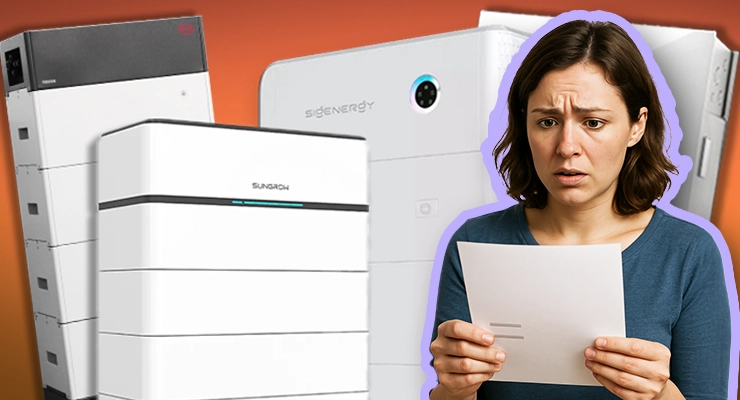Do home storage batteries affect home insurance premiums?
As more Australian households embrace energy independence, a common and important question arises: How does a new home battery system impact home and contents insurance? It’s a significant investment, and ensuring it’s protected is just as crucial as the energy savings it provides.
The short answer is that yes, installing a battery will affect your insurance because it adds significant value to your property. However, the process is generally straightforward, and the impact on your insurance premium is often less than you might think. Here’s what you need to know to navigate the conversation with your insurer with confidence.
Why must you notify your insurer?
A home battery is considered a permanent fixture, much like a hot water system or a newly renovated kitchen. Therefore, it falls under your building insurance policy. The primary reason to contact your insurer is to update your ‘sum insured’—the total amount it would cost to rebuild your home.
Failing to increase your sum insured to include the value of your new battery system could leave you underinsured. If a fire, storm, or other insured event destroyed your home, your policy might not cover the full cost of replacing both your house and the battery system. It’s important to understand that insurance covers these specified events, not mechanical failure or performance issues, which are the responsibility of the manufacturer’s warranty.
Insurers in Australia, such as Suncorp and NRMA, typically cover permanently fixed solar and battery systems as part of their home building insurance policies, provided you have informed them and adjusted your sum insured to reflect the system’s replacement cost.
How will a battery affect your insurance premium?
Because you are increasing the value of your insured property, you can expect a corresponding increase in your premium. This increase isn’t a penalty or a reflection of high risk; it simply reflects the higher replacement cost of your home. For most homeowners, this is a modest and worthwhile cost to ensure their investment is fully protected.
It’s a common misconception that insurers view modern, professionally installed battery systems as a high fire risk. While there are valid concerns about fires related to smaller, unregulated lithium-ion batteries in devices like e-scooters, home energy storage systems (BESS) are in a different category. They must be installed to rigorous Australian safety standards to minimise these risks.
The critical role of compliant installation
Your insurer’s willingness to cover your battery system hinges on one non-negotiable factor: compliant installation. As of 29 May 2024, the accreditation scheme for solar and battery installers fully transitioned to Solar Accreditation Australia (SAA), which took over from the Clean Energy Council (CEC). Your system must be installed by an SAA-accredited professional and comply with Australian Standard AS/NZS 5139. This standard dictates crucial safety measures, including:
- Correct location: Prohibiting installation in habitable areas like bedrooms or living rooms.
- Safety clearances: Mandating minimum distances from windows, doors, and heat sources.
- Fire-resistant barriers: Requiring protective barriers if the unit is installed near certain combustible materials.
Attempting a DIY installation or using an unaccredited installer will not only void your battery’s warranty but will also almost certainly void any related insurance claim. In the event of a fire or damage caused by a non-compliant installation, your insurer would have the right to deny your claim. After the work is complete, your installer must provide a Certificate of Electrical Safety/Compliance, which is essential documentation for any future claims.
Are some battery types considered safer by insurers?
While insurers don’t typically specify preferred battery brands, the technology inside can make a difference. Lithium Iron Phosphate (LiFePO₄) batteries are widely regarded as the most thermally stable and safest residential battery chemistry currently available. They are inherently less prone to “thermal runaway”—a rare but serious overheating event—compared to other lithium-ion chemistries.
Choosing a reputable brand with a strong Australian presence and support can also provide peace of mind. These systems feature sophisticated built-in Battery Management Systems (BMS) that constantly monitor temperature and performance to prevent faults. For instance, systems combining brands like AIKO (for solar panels) and Sigenergy (for batteries) integrate sophisticated safety and performance features.
Questions to ask your insurance provider
When you call your insurer, being prepared can make the process smoother. Here are the key questions to ask:
- I’m installing a home battery system. Do I need to list it as a specific item, or do I just increase my total sum insured?
- Does my policy have any specific exclusions related to home battery systems I should be aware of?
- What documentation do you require from me? (e.g., Certificate of Compliance).
- Can you confirm in writing that my policy fully covers the battery for events like fire, storm, and damage?
Keep a record of the conversation, including the date and the name of the representative you spoke with, and ask for any policy changes to be sent to you in writing.
The bottom line: protection and peace of mind
Installing a home battery is a fantastic step towards energy independence and lower power bills. While it requires a conversation with your insurer and a likely adjustment to your premium, it does not complicate your policy unnecessarily.
By using a certified professional to install a compliant, high-quality system, you ensure the safety of your home and the validity of your insurance. This small administrative step provides the ultimate peace of mind, protecting your investment and allowing you to enjoy the benefits of your new battery system for years to come.





